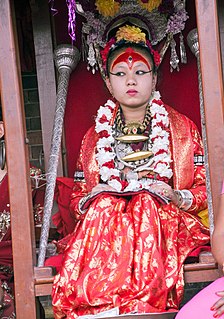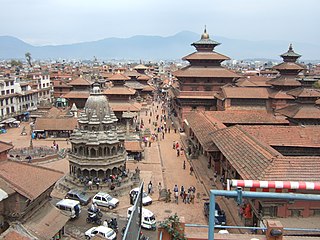
Kathmandu, officially the Kathmandu Metropolitan City is the capital and most populous city of Nepal with approximately 975,000 inhabitants in 2011. It is located in the Kathmandu Valley, a large valley in the high plateaus in central Nepal, at an altitude of 1,400 metres.

Kumari, or Kumari Devi, or Living Durga – Nepal, is the tradition of worshiping young prepubescent girls as manifestations of the divine female energy or devi in Asian religious traditions. The word Kumari is derived from the Tamil language "Kumari", meaning "Young Prepubescent Girl ".

Lalitpur Metropolitan City, historically Patan, is the third largest city of Nepal after Kathmandu and Pokhara, and it is located in the south-central part of Kathmandu Valley, a new metropolitan city of Nepal. Lalitpur is also known as Manigal. It is best known for its rich cultural heritage, particularly its tradition of arts and crafts. It is city renowned for its festival and feast, fine ancient art, and the making of metallic and stone carved statues. At the time of the 2011 Nepal census it had a population of 226,728 in 54,748 individual households. The city received extensive damage from an earthquake on 25 April 2015.

Patan is a town in the Indian state of Rajasthan. In the 12th century, it became the centre of a minor state called Tanwarawati or Torawati, ruled by Tomar dynasty. Anangpall II, who established the city of Patan and ruled present day Delhi, who is considered to be a direct descendant of Raja Parikshit, son of Abhimanyu and grandson of Arjuna the Pandavas of mahabharata.. “Anangpal II was instrumental in populating Indraprastha and giving it its present name, Delhi. The region was in ruins when he ascended the throne in the 11th century, it was he who built Lal Kot fort and Anangtal Baoli. The Tomar rule over the region is attested by multiple inscriptions and coins, and their ancestry can be traced to the Pandavas " said BR Mani, former joint director-general of the Archaeological Survey of India (ASI).

Devi Kanya Kumari is the manifestation of Parvati in the form of an adolescent girl child. Devi is also known as Shrī Bāla Bhadra or Shrī Bāla. She is popularly known as "Shakti" "Devi". The Bhagavathi Kumari Amman Temple is located in Kanyakumari in Tamil Nadu, at the southern tip of main land India, there by located on the confluence of the Bay of Bengal, the Arabian Sea, and the Indian Ocean. She is also known by several other names, including Kanya Devi and Devi Kumari. She is also worshiped as an incarnation of the goddess Bhadrakali by her devotees. Sage Parashurama is said to have performed the consecration of the temple. The goddess is believed to be the one who removes rigidity of the mind; devotees usually feel the tears in their eyes or even inside their mind when they pray to the goddess in devotion and contemplation.

Ganga is the personification of the river Ganges who is worshipped by Hindus as the goddess of purification and forgiveness. Known by many names, Ganga is often depicted as a beautiful fair woman, riding a divine creature called Makara. Some of the earliest mentions of Ganga are found in the Rigveda, where she is mentioned as the holiest of the rivers. Her stories mainly appear in post-Vedic texts such as Ramayana, Mahabharata and the Puranas.

Madhyapur Thimi, also known as Thimi, is a municipality in Bhaktapur District in the Bagmati Zone of central Nepal. Thimi lies between Kathmandu, Lalitpur and Bhaktapur in the Kathmandu Valley. It is one of the ancient cultural and historical places along the trade route from Bhaktapur to Kathmandu. The city is situated on elevated land and occupies an area of 11.47 square kilometres (4.43 sq mi), divided into nine administrative wards.

Tokha Chandeshwari is a village and former Village Development Committee that is now part of Tokha Municipality in Kathmandu District in Province No. 3 of central Nepal. At the time of the 2011 Nepal census it had a population of 3,961. Tokha Chandeshwari now is part of Tokha municipality.

Bungamati, Newar Bunga, lies in Lalitpur Metropolitan Region, Ward No. 22 in Lalitpur District, Nepal. Bungamati is a Newar town on a spur of land overlooking the Bagmati River

About 8 km south-east from the capital of Kathmandu, Nepal on the way to Godawari, Lalitpur, there is a historically renowned village named Harisiddhi, where the Temple of Harisiddhi is located. The temple is at the height of about 4,400 ft from the sea level, whose latitude is 270˚38' north and longitude is 850˚21' east. About 800m west from the temple, there is a river named Karmanasha (Kodku). The climate at this place is normal i.e. hot in summer and cold in winter. The temple is surrounded by the residential area. There is a pond to the south-east direction of the temple which is believed to be one of the important holy-ponds i.e. Kunda.

Kathmandu Durbar Square in front of the old royal palace of the former Kathmandu Kingdom is one of three Durbar Squares in the Kathmandu Valley in Nepal, all of which are UNESCO World Heritage Sites.

The architectural heritage of Kathmandu city is integral to that of the Kathmandu valley since all monuments have evolved over centuries of craftsmanship influenced by Hindu and Buddhist religious practices. The architectural treasure of the Kathmandu valley has been categorized under the well known seven groups of heritage monuments and buildings. In 2006, UNESCO declared these seven groups of monuments as a World Heritage Site (WHS). The seven monuments zones cover an area of 188.95 hectares, with the buffer zone extending to 239.34 hectares. The Seven Monument Zones (Mzs) inscribed originally in 1979 with a minor modification in inscribed year as 2006, are: Five monuments in Kathmandu – Durbar square of Hanuman Dhoka, Hindu temples of Pashupatinath and Changunarayan, the Buddha stupas of Swayambu and Boudhanath; and two monuments outside Kathmandu city limits, in the satellite towns of Patan and Bhktapur – Durbar square at Patan, Durbar square at Bhaktapur. Brief details of the five Kathmandu city monuments are elaborated here.

Bhaktapur Durbar Square, locally known as Khwopa Lyaku is the royal palace of the old Bhaktapur Kingdom, 1,400 metres (4,600 ft) above sea level. It is a UNESCO World Heritage Site.

Rato Machindranath Jatra is a chariot procession honouring the Vajrayani Buddhism deity of compassion Avalokiteśvara and as an incarnation of shiva for hindu people which is held in Lalitpur, Nepal. It is one of the greatest religious events in the city and the longest chariot festival celebrated in the country.

Gajalu is a Nepali movie that depicts the life of living goddess Kumari after her retirement. Shristi Shrestha plays the role of Sujata Shakya, a former Kumari. The movie is about her friendship with her six friends who happen to change her life. This movie is partly inspired by novel named Half Girlfriend by Chetan Bhagat.
Chanira Bajracharya is a former Kumari or Living Goddess of Patan in Nepal. She was born in Nepal, chosen as living goddess in April 2000, and enthroned when she was five years-old. Her reign ended when she reached puberty at the age of 15 when she menstruated for the first time, as is customary for Kumaris. She was succeeded by Samita Bajracharya.
Rashmila Shakya is a Nepalese writer, software engineer, and Programme Director for Child Workers in Nepal. She authored the autobiography From Goddess to Mortal: the True Life Story of a Former Royal Kumari, which documents her time as Royal Kumari of Kathmandu.
Dhana Kumari Bajracharya is a Nepalese Kumari (goddess). Until the April 2015 Nepal earthquake, she did not walk. Because her menstruation did not start, she reigned in official Patan Kumari for three decades. In 1984, she was replaced without consent. She lives as kumari. Chanira Bajracharya is her niece.

Naradevi Temple, also called Swetakaali Temple an ancient Hindu temple located in the older parts of Kathmandu, Nepal. It is believed that occult and tantric rituals are performed in the temple and there is a female energy in the temple. The goddess housed in the temple, Sweta Kali is believed to receive human sacrifice in the ancient times. The goddess is also referred as Neta Ajima by the Newar community. The goddess is also considered to be the mother of the goddess Kumari Chandeswori Bhagwati.















